|
| |
[View / Print / Save this letter as a PDF file.
(2.38MB)] [Download Adobe Reader
PDF file reader.] 20 June 2008 Click on the
pictures to enlarge them.
Greetings again from New Mexico. Generally speaking, Albuquerque has been quite
dry this year, although the mountains received a lot of snow during the winter.
We are sending this letter out a little before 4 July since we plan to be on the
road on a trip beginning 26 June. We had spent April on the road and have been
home since 1 May.
APRIL ADVENTURE
On 5 April we drove down to White Sands Missile Range. There we met up with
Jim Maultsaid. He was here on vacation from Northern Ireland. We met at Trinity
Site.
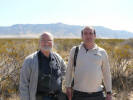 Robert with Jim at Trinity Site.
Robert with Jim at Trinity Site.
That is where the first atomic bomb was tested on 16 July 1945. The site is only
open to the public twice a year.
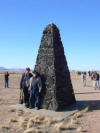 This monument marks ground zero.
This monument marks ground zero.
Robert had been there about 37 years ago. We had both been there in the early
1980s. Since our visit, the McDonald farm house had been restored and opened to
the public. The farm house is where the bomb had been assembled.
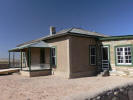 The McDonald farm house.
The McDonald farm house.
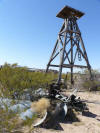 The McDonald windmill.
The McDonald windmill.
(Not in printed newsletter.)
Jim spent the night with us, and the next day we all took off and headed north.
Jim went to Dulce, New Mexico, while we went to McPhee Reservoir in Colorado. We
continued north to Salt Lake City where we stayed for five days. We spent that
time in the Family History Library discovering more facts about our ancestors.
Jim met up with us one afternoon at the library and we were able to find some
information about his ancestors when they lived in Philadelphia in the late
1800s. (Our big surprise regarding family history was learning via a
Philadelphia newspaper article of 1892 that Robert's great grandfather had
abandoned his family and disappeared with all the money.) The weather in Utah
was still pretty chilly and the snow remained heavy on the mountains. We could
see snow on all the mountain ranges as we traveled west from Salt Lake City into
Nevada.
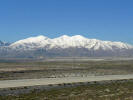 Snowy mountain ranges in western Utah.
Snowy mountain ranges in western Utah.
There was snow on the mountains and salt on the ground at Bonneville Salt Flats.
 Derry with Robert on Bonneville Salt Flats.
Derry with Robert on Bonneville Salt Flats.
Our first stop in Nevada was at Winnemucca. The next day as we drove on to
Virginia City the weather turned cold and extremely windy. The following morning
in Virginia City, our water hose was frozen solid. We enjoyed our two days in
the old mining town in spite of the chilly weather. The city is in the famous
mining district - home of the Comstock Lode. There are many historic buildings
throughout the town as well as several museums devoted to showing life in the
1800s. One is a stamp mill that has just recently been restored so that visitors
can see how the mill was used to extract gold from ore.
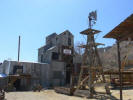 Stamp Mill in Virginia City.
Stamp Mill in Virginia City.
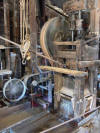 Here we see the stamps (at right) crushing the ore.
Here we see the stamps (at right) crushing the ore.
When we were in Australia in 2005, we toured an operating stamp mill at
Sovereign Hill, Ballarat, Victoria. In Virginia City, we learned that there are
only two operating stamp mills known in the world and we have been to both.
(probably the only people who have) During the Civil War, Samuel Clemens worked
as a reporter in Virginia City in the building at left in this photo.
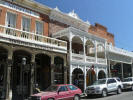 Virginia City street scene.
Virginia City street scene.
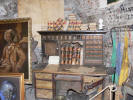 Samuel Clemens’ (Mark Twain’s) desk.
Samuel Clemens’ (Mark Twain’s) desk.
Our next destination was in California so we crossed the Sierra Nevada Mountains
at Donner Pass and headed down into the Sacramento River valley. We spent a
night near Rocklin where we visited Linda's cousin, Mindy Sanderson, and her
family.
 Linda with Mindy, Ray, little Ray, and Ryan.
Linda with Mindy, Ray, little Ray, and Ryan.
We visited Linda’s cousin, Jim Greer, in Brentwood the next day and got to meet
his daughter, Ashley, for the first time.
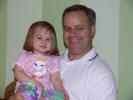 Jim and Ashley.
Jim and Ashley.
We finally arrived at the Pacific coast on 18 April at an RV park just south of
San Francisco. There was a beautiful view of the ocean from our campsite.
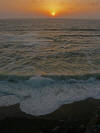 The sunset that evening was wonderful.
The sunset that evening was wonderful.
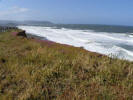 Surf rolls in at Pacifica, CA.
Surf rolls in at Pacifica, CA.
We spent the next day in San Francisco. We parked at Pier 39 and walked along
the waterfront as far as Ghirardelli Square. We took a cruise out into the bay
as far as the Golden Gate Bridge and then around Alcatraz Island.
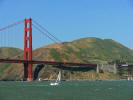 Golden Gate.
Golden Gate.
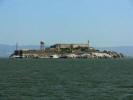 Alcatraz Island.
Alcatraz Island.
After the cruise, we walked down to the San Francisco Maritime National Historic
Park museum at Hyde Street pier. The museum and ships on display at the pier
were interesting.
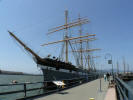 Tall ship at Hyde Street pier.
Tall ship at Hyde Street pier.
At Ghirardelli Square we had to purchase and sample some chocolate. Robert will
never forget the best hot fudge sundae that he has ever eaten.
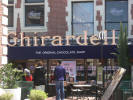 Ghirardelli Square chocolate shop.
Ghirardelli Square chocolate shop.
We then took the cable car across town and returned via a different route to
where the car was parked.
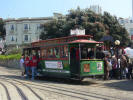 Cable car ready to go.
Cable car ready to go.
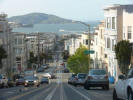 Heading down.
Heading down.
The next day we went a short distance to San Jose where we met Kristin Patterson
who is a philatelist interested in the revenue stamps (and life story) of Samuel
Dexter Hastings who married Robert's g-g-g-grandaunt Margaretta Shubert in 1837.
While we were in Salt Lake City, Robert had found their marriage entry in the
records of the 11th Presbyterian Church as well as some other marriage records
that Samuel had signed. During the Civil War, Samuel was Treasurer of the state
of Wisconsin. Kristin has a collection of his revenue stamps, checks, etc.
 Robert and Kristin.
Robert and Kristin.
We had never been to Sequoia and Kings Canyon National Parks, so our next stop
was at an RV park on the Kaweah River near the entrance to Sequoia.
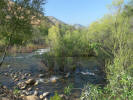 At the Kaweah RV Park.
At the Kaweah RV Park.
The parks are in the Sierra Nevada Mountains and are known for their giant
trees. The sequoia trees are the largest in the world. They are not as tall as
Redwood trees, but they are much larger in diameter. The largest Sequoia is the
General Sherman tree.
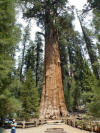 General Sherman tree.
General Sherman tree.
 Linda dwarfed by General Sherman.
Linda dwarfed by General Sherman.
We saw a mother bear up a tree with her cub.
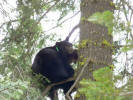 Bears on a stick.
Bears on a stick.
We also hiked up to the top of a granite dome with a tremendous view.
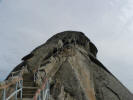 Hiking up the granite dome.
Hiking up the granite dome.
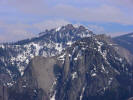 View at the top.
View at the top.
We left the mountains, spent a night in Inyokern, and then drove into Death
Valley at 280 feet below sea level. We had been there 28 years ago. At that time
we camped in a tent on a couple hot June days. This time we were much more
comfortable in our motor home in cooler weather. We visited Scotty's Castle and
then hiked a short distance into Titus Canyon.
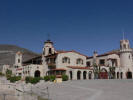 Scotty’s Castle.
Scotty’s Castle.
 Titus Canyon.
Titus Canyon.
We then toured various sites down the valley.
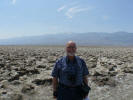 Robert at the Devil’s Golf Course.
Robert at the Devil’s Golf Course.
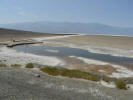 Badwater.
Badwater.
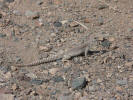 Lizard visits at Ashford Mill.
Lizard visits at Ashford Mill.
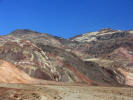 Colorful view on the Artists Drive.
Colorful view on the Artists Drive.
 Colorful view on the Artists Drive.
Colorful view on the Artists Drive.
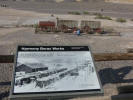 Harmony Borax works. Waiting for the 20-mule team.
Harmony Borax works. Waiting for the 20-mule team.
Our next destination was one we had also visited 28 years ago. We camped at
Valley of Fire State Park east of Las Vegas, Nevada. The park is named for the
bright red rocks that are visible everywhere.
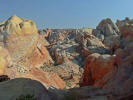 Multi-colors at Valley of Fire.
Multi-colors at Valley of Fire.
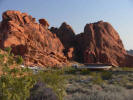 Red rocks at the campground.
Red rocks at the campground.
After leaving the Valley of Fire we drove across Hoover Dam and into Arizona.
Vehicles crossing the dam are inspected by the Department of Homeland Security.
Fortunately we did not have to wait very long. A bridge is currently under
construction which will provide a bypass high above the Colorado River canyon.
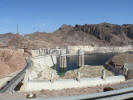 Hoover Dam forms Lake Mead.
Hoover Dam forms Lake Mead.
We next camped at the Grand Canyon and spent a day exploring various places
along the south rim of the canyon. There is a new Visitor Center in the Park as
well as an extensive shuttle bus system to handle the many visitors to the park.
As we traveled through the various parks we noticed that there were a large
number of tourists from Europe. At some places we seemed to be the only
Americans around.
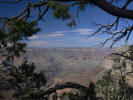 Grand Canyon view.
Grand Canyon view.
Here are three bonus panoramic pictures that would not fit into the printed
newsletter.



Our final campsite was at Canyon de Chelly National Monument. (pronounced “da
Shay”) We spent an extremely windy day viewing the north and south branches of
the canyon. The final stop at Spider Rock overlook was sheltered from the wind
as Robert took the photos that are pieced together to make the panorama shown
below.
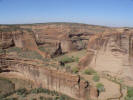 Canyon de Chelly overlook.
Canyon de Chelly overlook.
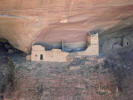 Ruins in the canyon.
Ruins in the canyon.
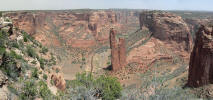 Spider Rock at Canyon de Chelly is over 800 feet high.
Spider Rock at Canyon de Chelly is over 800 feet high.
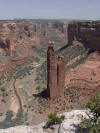 Additional photo of Spider Rock not in printed newsletter.
Additional photo of Spider Rock not in printed newsletter.
On our way to Albuquerque on the last day of our trip we stopped at the historic
Hubbell Trading Post.
 Historic Hubbell Trading Post.
Historic Hubbell Trading Post.
The trip was 3,075 miles and took $1,464 worth of gasoline. It was most
expensive in California at $3.80 per gallon, but now it has reached that level
in Albuquerque. We are currently getting ready for a trip to the east coast that
will be over 6,000 miles in length. Some of that journey will be through the
flood-ravaged areas in Iowa and Wisconsin.
SURGERY
In February, Robert began to have pain in his right wrist. The orthopedics
doctor determined that he had De Quervain's Tenosynovitis. A cortisone shot did
not help. He saw the doctor again after we returned from our trip. Another shot
did not help very much, so surgery was scheduled for 30 May. It was successful
and Robert is now recovering well. He just has to take it easy for a month.
ROBERT
Robert did some Science Fair judging as he often does. In January it was at
Hope Christian School and in March he judged at the NW New Mexico regional fair
on behalf of the American Institute of Aeronautics and Astronautics (AIAA). In
February he visited Petroglyph Elementary School and gave a presentation on
Stars to 4th grade classes.
THE BOTTOM LINE
We continue to be thankful for the Lord’s provision for us. We trust in Him,
and pray that you will do likewise and enjoy a wonderful summer of 2008.
Love,
Robert & Linda
Return to top of page.
Page last updated:
19 June 2008
|
